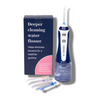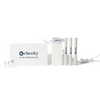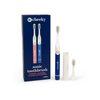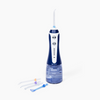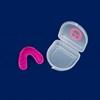In a perfect world, your teeth-related woes would end once you got your braces off.
While your braces may help guide your bite into perfect alignment, getting the hardware removed can sometimes lead to other issues. One of the more prevalent issues in individuals who recently got their braces off is a temporomandibular joint disorder (often called TMD or TMJ).
There’s no definitive evidence that braces cause TMD, but it’s not uncommon for people who had braces to develop TMD.
Let’s take a deeper look.
What Are the Temporomandibular Joints (TMJs)?
Your temporomandibular joints (TMJs) are the little hinges that connect your lower jaw to your skull. Your TMJs are what enable you to talk, chew, and make funny faces on Snapchat.
As long as your TMJs and the other muscles in your jaw are in alignment, you shouldn’t have any problem opening or closing your mouth or wiggling your jaw from side to side. But when these joints and muscles fall out of alignment, you may start to feel some tension in your jaw.
What is a Temporomandibular Joint Disorder (TMD)?
When your TMJs are out of whack, you might develop a temporomandibular joint disorder (TMD). There are three common reasons a dentist might diagnose you with TMD:
- Myofascial pain: most TMD diagnoses come from when you experience discomfort in the muscles surrounding your jaw, neck, or shoulders
- Internal derangement of the joint: when you have a dislocated jaw, displaced disk in the cartilage between the head of your jaw bone and skull, or an injury to the rounded edge of the jaw bone (condyle)
Degenerative joint disease: when you have osteoarthritis or rheumatoid arthritis in one or both of your jaw joints
Causes of TMD
As we said before, it’s unclear whether braces directly lead to TMD. But in all fairness, it’s challenging to determine the exact cause of TMD for most cases, especially for the disorders diagnosed based on myofascial pain.
Some of the potential causes of TMD include:
- Excessive strain on the TMJs
- Bruxism (teeth grinding)
- Trauma to the jaw, head, or neck
- Medical conditions such as fibromyalgia or irritable bowel syndrome (IBS)
- Other clinical, psychological, sensory, genetic, and nervous system factors
In short, the direct cause of TMD often leaves behind a giant question mark. All you know is that your jaw hurts, and you want it to stop hurting.
What Are the Signs and Symptoms of TMD?
Everyone experiences jaw pain occasionally, especially if you literally just got your braces off and your mouth is adjusting to not having a bunch of metal attached to your teeth 24/7. However, TMD becomes an issue when jaw pain and other symptoms become chronic.
Common signs and symptoms of TMD include:
- Jaw soreness or discomfort, especially in the morning or late afternoon
- Headaches
- Pain spreading behind your eyes and in your face, shoulder, neck, and/or back
- Earaches or ringing in your ears (given that an ear infection has already been ruled out)
- Clicking or popping noises when you move your jaw
- Jaw locking
- Limited jaw mobility
- Teeth grinding or clenching
- Dizziness
- Teeth sensitivity (given that an oral health disease has already been ruled out)
- Feelings of numbness or tingling in your fingers
- Changes in the way your teeth fit together (the biggest reason why braces and TMD may go hand in hand)
Talk to your dentist if you’re experiencing any of these symptoms, and they don’t seem to go away.
Start by Treating the Root Cause If Possible
Sometimes, TMD isn’t a standalone issue. To take care of TMD for good, you might need to address a bigger-picture issue. For example, some people develop a TMD because of chronic bruxism. Frequent teeth grinding can lead to extra tension in your jaw, which can throw off normal jaw function.
Talk to your doctor or dentist about what may be causing your TMD so you can develop a treatment plan to address the underlying problem.
Invest in a Night Guard
One of the easiest ways to combat TMD is to get a mouthguard to wear while you sleep. For best results, get a custom nightguard that’s shaped to your teeth so your guard relieves tension while maintaining your natural alignment.
Try TMJ Exercises
Like any other muscle in your body, you can exercise your jaw! Health experts believe that TMJ exercise can relieve TMD symptoms by strengthening and stretching jaw muscles, increasing jaw mobility, and relieving tension in the jaw.
Save this handy-dandy article by Healthline and practice these nine exercises daily to see a difference in your jaw function.
Discuss Treatment with Your Doctor or Dentist
For severe cases of TMD, holistic remedies may not be enough to give you the pain relief you’re looking for. If other treatments fail, you may want to talk to your doctor or dentist about alternative therapies.
Other methods of treating TMD include:
- Prescription medication for relieving pain, relaxing muscles, or reducing inflammation
- Botox injections to reduce stress on the jaw joints
- Acupuncture to relieve pain and limit inflammation
Your doctor or dentist will likely only recommend these treatments if nothing else has helped, so it’s essential to be honest about where you are in your treatment.
Do I Have to Choose Between My Retainer and Night Guard?
Once you got your braces off, your orthodontist likely handed you a retainer that you need to wear every night to keep your teeth straight. But how are you supposed to wear your retainer AND your nightguard?
There’s no reason you have to choose between the two appliances. With a custom mouthguard, you can opt to have one fashioned for your lower teeth. This way, you can still wear your retainer on your top teeth. You might look a little silly, but you’ll be sleeping anyway, so who cares?
At Cheeky, we let you tailor your nightguard to your preferences, including getting a guard fashioned to your lower teeth. Don’t let post-braces TMD get you down and get started with Cheeky today.
